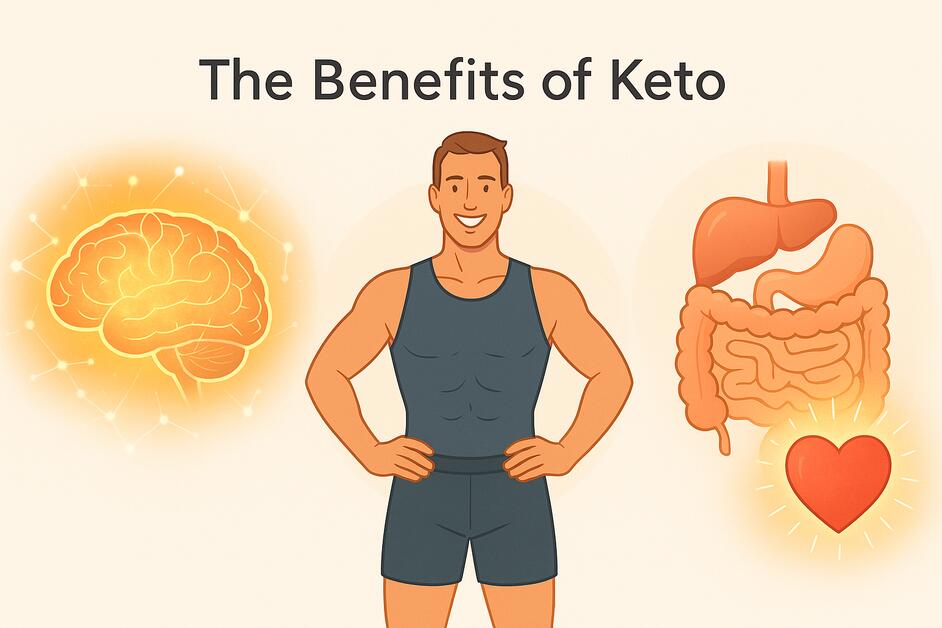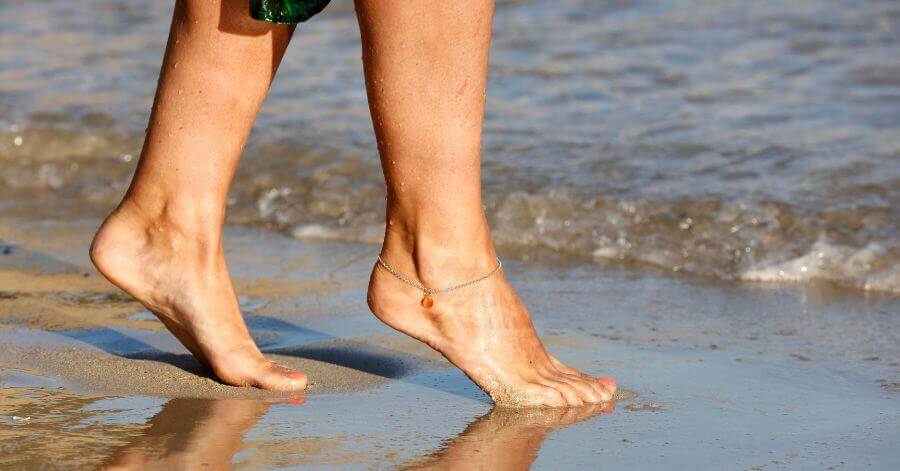
The Benefits of The Ketogenic Diet
The benefits of the ketogenic diet include weight loss, improved energy, and better blood sugar control. It promotes fat burning and mental clarity.

Since 2022, the number of Google searches for “Grounding” has rapidly increased to an all-time high as of July 2024.
But why such an increase in interest in something much of the scientific community has deemed “pseudoscience” for so long? Is there any scientific rationale behind this controversial topic, or is it simply a placebo and wishful thinking?
This article will detail what the latest science says about grounding, including its scientific merits and detractions, and whether incorporating grounding into your everyday life is worth it.
Could earthing be one of the greatest kept secrets when it comes to our health, another gimmick aiming to strip us of our hard-earned money, or somewhere in the middle? Let’s investigate.
Grounding, often called earthing, is the practice of connecting the body directly to the Earth’s surface electrons by walking barefoot outside or using grounding devices to promote various health benefits.
The theory of grounding, or earthing, is based on the idea that the Earth’s surface has a negative electric charge due to an abundance of free electrons. We know this to be true due to the electric field that extends from the ionosphere, a scientific principle that has been studied extensively, and the reason why lightning discharges help to maintain the Earth’s negative charge by transferring electrons from the atmosphere to the ground.
The main principle of grounding is that when the human body comes into direct contact with the Earth—by walking barefoot on grass, sand, or soil, or using grounding devices that connect to the Earth’s energy—these electrons are then absorbed by the body if it is more positively charged.
The body is not naturally positively charged in the sense that it holds a static positive charge, but rather it can accumulate positive charges due to the modern environment and lifestyle.
Activities like walking on synthetic floors, wearing rubber-soled shoes, and being exposed to electronic devices can lead to an imbalance of positive charges, or a deficiency in negative electrons, in the body.
We can test this theory directly by holding a voltage meter when grounded and not grounded, as shown in the video below. So we know that grounding on the earth and using grounding equipment such as mats do work to ground you and make your net electrical charge zero. The question is how much of an effect this has on our health, if at all.
The promotion of grounding devices is controversial, even for those who believe there is some merit to grounding. And they are right to be cautious – in a consumer-driven world where companies often prioritize profit over efficacy, it’s crucial to assess the trustworthiness of these products.
There are now quite a few studies, many peer-reviewed, that have sought to demonstrate the possible benefits of grounding, both directly on humans and indirectly on humans and animals.
Keep in mind that many of these studies are funded in part by independent contractors working on behalf of companies selling grounding products. This doesn’t automatically discredit them, but it is something to keep in mind when reading through the experimental procedures.
On the other hand, funding for such studies is extremely difficult to obtain for free treatment options such as grounding, unlike other pharmaceutical treatments that stand to make fortunes. Those who want to prove the merits of grounding often have little choice but to fund it themselves.

Inflammation is the body’s local response to injury or infection, helping to isolate damaged areas until the immune system can clear out harmful substances and cells.
This is useful for short-term injuries, where the inflammation reduces upon healing, but inflammation sometimes causes more damage than the initial cause. Sepsis is a prime example, where the body’s inflammatory response is often more destructive than the infection itself.
For ongoing longer-term inflammation, called “silent inflammation,” persisting for months or years, this chronic inflammation can harm nearby healthy tissues and weaken the immune system, often exceeding the severity of the disease or injury itself.
These situations pose a challenge for doctors because a small area of chronic inflammation from an old injury can release toxins into the body. The difficulty lies in pinpointing the source, which could stem from inflammation due to an old injury, an undetected dental issue like a cavitation or root canal, or a hidden tissue injury.
Preliminary research has opened the possibility that grounding may aid in the reduction of short-term and long-term inflammation and the associated inflammatory markers. This study, for example, showed a reduction in heat from inflamed areas in a 33-year-old woman who suffered a long-term gymnastics injury at age 15.
The top image in Panel B shows an arrow pointing to her knee where the pain and inflammation were found. The lower images in Panel B were taken after 30 minutes of being grounded with an electrode patch, after which the patient reported a mild reduction in pain.
While the methodology of this example has been fairly criticized (the before image was taken while running and the bottom after 30 minutes of grounding and rest), the self-reported response by the patient was impressive. After 4 weeks of treatment, she played soccer with minimal pain, which she described as a first for 15 years, and after six months, she completed her first half-marathon.
The study suggested that connecting the body to the Earth allows free electrons from the Earth’s surface to spread into the body, where they act as antioxidants and create an antioxidant environment around injury sites, preventing reactive oxygen species (ROS) from causing damage to healthy tissue and reducing the formation of inflammatory barriers.
It’s important to note that, although intriguing, the claim that free radicals act as antioxidants is controversial and not fully established in scientific literature. There is, however, an overwhelming amount of anecdotal evidence such as this suggesting a reduction in inflammation through grounding that it would be unwise to simply discredit.
Aging is a natural, unavoidable, and ongoing process influenced by both internal and external factors. One important factor in aging is oxidative stress (although just one of many probable causes), which occurs when there’s an imbalance between harmful prooxidant molecules and protective antioxidant molecules.
While the idea that reducing oxidative stress could extend lifespan hasn’t been consistently proven in thorough studies, some studies have found that high levels of prooxidant molecules have been linked to age-related diseases in animal models, suggesting a complex role for oxidative stress.
Some pilot studies have indicated that grounding the human body during sleep reduces night-time levels of cortisol, which are indirectly related to oxidative stress.
Unfortunately, there simply isn’t enough data to make more substantial claims, and the relationship between grounding and its effects on oxidative stress is not yet robust or universally accepted within the scientific community. But it is certainly something that should be researched further.
There has been a curious rise in cases of diabetes since around the mid-1950s, around the same period that leather shoes were gradually being replaced with the non-conductive synthetic soles 95% of all footwear have today.
No one is suggesting that this is the sole cause of increased rates of diabetes, but a fair question arises of whether this observation represents coincidence or correlation.
Of course, overconsumption of sugary foods, sedentary lifestyles, and the use of high fructose corn syrup sweeteners significantly contribute to the growing diabetic population. However previous research in both animal and human studies has indicated that blood sugar levels rise when rats and humans are disconnected from the Earth.
In a study involving twelve patients with non-insulin-dependent diabetes mellitus (type 2 diabetes), grounding increased their glucose utilization, which suggests improved blood sugar control. The researchers proposed that not being in contact with the Earth might have the opposite effect, potentially worsening conditions like diabetes, obesity, and high blood pressure.
In another small clinical investigation, grounding effects were studied on hypertensive individuals – those who suffer from high blood pressure.
The study involved ten participants, all of whom were taking one to three medications for high blood pressure, to observe the impact of grounding on blood pressure levels.
Every participant experienced a reduction in their blood pressure, and many were able to decrease their dependence on anti-hypertensive medications. Specifically, the study reported that systolic blood pressure levels dropped by 8.6% to 22.7%, with an average reduction of 14.3%.
Additionally, the pilot study highlighted that grounding for a minimum of 10 to 12 hours per day resulted in significant blood pressure reduction, suggesting that grounding could be a beneficial complementary approach for managing hypertension.
While this is not proof of causation, the correlation is intriguing and deserving of more attention.
One of the most common self-reported benefits of grounding is its effects on relieving stress and anxiety.
This anecdotal evidence has also been documented in at least five studies, particularly grounding’s effect on physiological and emotional stress.
Like inflammation, the stress response is a very handy short-term response to deal with immediate stressors, like entering the “fight-or-flight” response when confronted with a dangerous situation.
Sustained chronic stress, however, like emotional distress from domestic abuse, can lead to unhealthy levels of stress chemicals such as cortisol that cause all manner of damage, such as a disruption of the body’s circadian rhythms, sleep disorders, hypertension, and cardiovascular disease.
Grounding has been shown to have a normalizing influence on cortisol, as demonstrated through calming impacts on the electrical activity of the brain.
This study looked at how using earthing mats affects stress and anxiety in animals. Results showed that animals with earthing mats were less anxious, spending more time in the open areas of an elevated maze, which typically indicates lower anxiety. Additionally, these animals had lower levels of corticotropin-releasing factor (CRF), a hormone related to stress.
The study also found that earthing mats seemed to help stabilize the animals’ physiological processes, demonstrating a trend toward lower neuronal activation, although this wasn’t statistically significant. Although there have been no such tests in humans, it’s not unreasonable to expect a similar result.
As a regular gym-goer, I’m particularly interested in grounding’s ability to improve responses to tissue and muscle damage for improved athletic performance.
This study divided 32 healthy young men into two groups: one that was grounded to the Earth and another that was not (sham-grounded). Both groups performed 200 half-knee bends to induce muscle strain, while researchers measured their pain levels and took blood samples over 2 days.
The grounded group experienced less muscle damage, as indicated by lower levels of creatine kinase (CK), an enzyme that rises with muscle injury. On the second day, the sham-grounded group had a significant increase in CK, whereas the grounded group did not, showing a clear difference between the two. Additionally, the grounded group had more neutrophils (a type of white blood cell) and increased platelets, which are important for blood clotting, on certain days.
While the science behind grounding is complicated, incorporating it into our daily lives is fortunately simple and enjoyable.
Whether or not the science can or will be proven, or whether the effects are nothing more than a placebo, there is zero harm and zero risk in trying.
Many sources claim that 30 minutes a day of earthed contact (such as walking barefoot or lying on the grass) is enough to induce benefit. Other studies for more intense pain and inflammation noted improvements between 6 and 10 hours.
Unfortunately, there is no exact time range that can be given with much confidence, but considering it is zero risk, it is fair to say that some is good and more is better.
Grounding sleep mats and blanket covers can be purchased with the idea of being grounded for extended periods overnight for those willing to try. Otherwise, mats can be purchased to ground at a desk while working, and even grounded shoes are now becoming more common.
But the best thing about grounding is that it is supposed to be free and easy. Walking barefoot on the grass outside is the best way to get started for those curious and willing to try. What have you got to lose?

Grounding the body has been shown to produce significant health benefits by providing electrons from the earth, which help reduce inflammation and oxidative stress. Modern lifestyles have disconnected most people from this natural source of electrons, potentially contributing to chronic inflammation and diseases.
Grounding has been shown to improve conditions like high blood pressure, heart rate variability issues, and blood viscosity through numerous studies, although these studies are still criticized by many in the scientific community.
When we reconnect with the earth, electrons flow into the body, enhancing its defense mechanisms and supporting healing. This natural anti-inflammatory process can help with diabetes, autoimmune diseases, cardiovascular disease, and other inflammatory illnesses.
Though still a developing field in 2022, grounding shows promise as a preventive and therapeutic approach for improving health and quality of life.
Grounding, often called earthing, is the practice of connecting the body directly to the Earth’s surface electrons by walking barefoot outside or using grounding devices to promote various health benefits.
There are now quite a few studies, many peer-reviewed, that have sought to demonstrate the possible benefits of grounding, both directly on humans and indirectly on humans and animals.
Keep in mind that many of these studies are funded in part by independent contractors working on behalf of companies selling grounding products. This doesn’t automatically discredit them, but it is something to keep in mind when reading through the experimental procedures.
Many sources claim that 30 minutes a day of earthed contact (such as walking barefoot or lying on the grass) is enough to induce benefit. Other studies for more intense pain and inflammation noted improvements between 6 and 10 hours.
Unfortunately, there is no exact time range that can be given with much confidence, but considering it is zero risk, it is fair to say that some is good and more is better.

The benefits of the ketogenic diet include weight loss, improved energy, and better blood sugar control. It promotes fat burning and mental clarity.

Procrastination may seem illogical, but there are strong biological reasons behind it. These tips will show you how to stop procrastinating for good.

Emotions stem from the limbic system, an impulsive and primal part of the brain that is extremely powerful. Unfortunately, no one teaches us how to manage emotions, but thankfully these books will.

The benefits of grounding have been scientifically studied and include reductions in inflammation, diabetes, and stress.

Goals are easy to set but often difficult to follow through with. Learn the neuroscience behind behavior change and how to use it to your advantage to set unbreakable goals.

Logical and rational thoughts stem from the conscious mind, whereas emotional and impulsive thoughts are induced from the subconscious mind, which is beyond our control.
© 2025 Modern Mind Masters - All Rights Reserved
You’ll Learn:
Effective Immediately: 5 Powerful Changes Now, To Improve Your Life Tomorrow.
Click the purple button and we’ll email you your free copy.